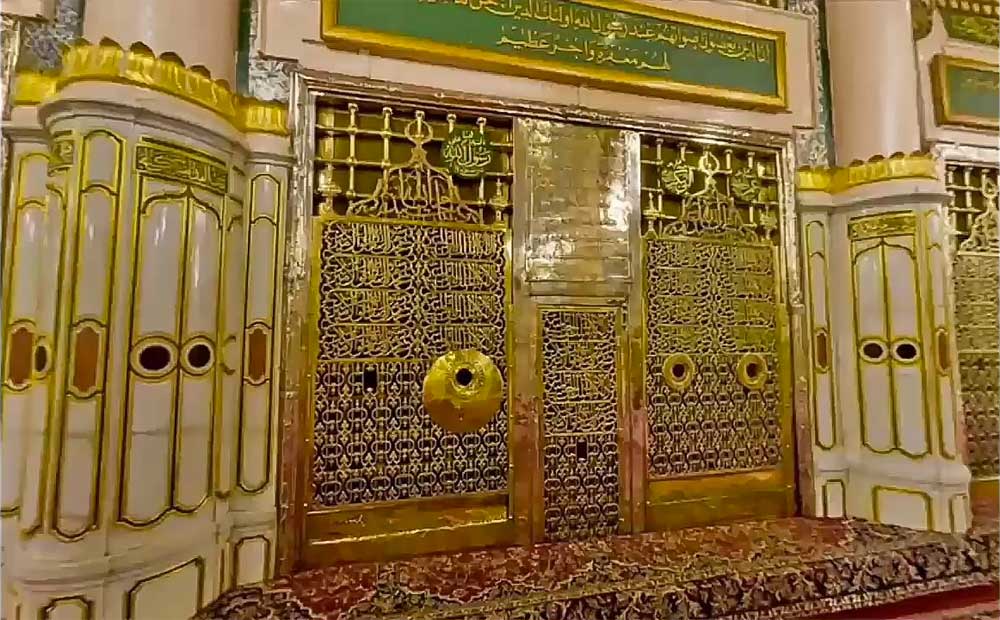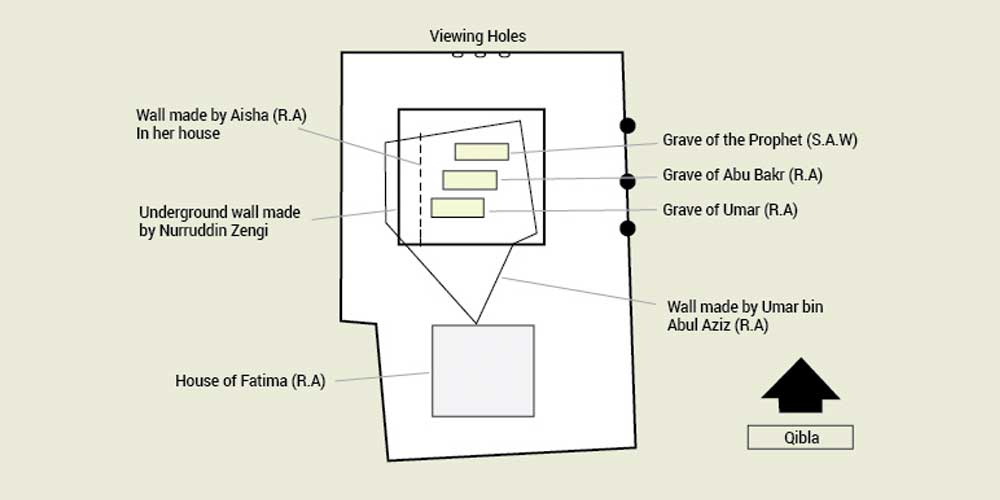Rawdah Mubarak (Sacred Chamber)

This gold grill is the front part of the Rawdah Mubarak, the Sacred Chamber in which the Prophet Muhammad (peace and blessings of Allah be on him) passed away and where he is buried. It also houses the graves of the first two Caliphs of Islam, Abu Bakr (may Allah be pleased with him) and Umar (may Allah be pleased with him).
- With regards visiting Medina and performing the Ziyarah (visiting the grave of the Holy Prophet (peace and blessings of Allah be on him)), the Prophet (peace and blessings of Allah be on him) said: “ Whoever visits me after my death is like he who had visited me during my life.” [Tabraani] “ Whoever performs his Hajj in Mecca, then comes to Medina with the sole aim of visiting me in my Masjid, for him shall be written (the rewards of) two accepted Hajj.” [Daylami] “ When a person stands at my grave reciting blessings on me, I hear it; and whoever calls for blessings on me in any other place, his every need in this world and in the hereafter is fulfilled and on the day of Qiyamah I shall be his witness and intercessor.” [Bayhaqi]
- The viewing holes above are aligned to the faces of the inhabitants of the graves. The largest hole on the left directly faces the noble face of the Prophet Muhammad (peace and blessings of Allah be on him). The one in the middle is aligned to the face of Abu Bakr (may Allah be pleased with him) and likewise the one on the right is aligned to the face of Umar (may Allah be pleased with him).

Rawdah Mubarak - plan view diagram
- The Prophet (peace and blessings of Allah be on him) was buried in the house of Aisha (may Allah be pleased with her) in whose house he was staying at the time of his death. The wives of the Prophet (peace and blessings of Allah be on him) lived in small, simple huts adjacent to the masjid. Each hut consisted of a room which was approximately 5m x 4m with a small backyard and were made of unbaked bricks of mud with branches of palm tree as a roof covering.
- On the left side of the hut of Aisha (may Allah be pleased with her) was the hut of Sauda (may Allah be pleased with her), the second wife of the Prophet (peace and blessings of Allah be on him). The hut of Hafsa (may Allah be pleased with her), another wife of the Prophet (peace and blessings of Allah be on him) and the daughter of Umar (may Allah be pleased with him) was on the opposite side. There used to be a very narrow street between their houses, just enough for one person to walk through. Aisha (may Allah be pleased with her) and Hafsa (may Allah be pleased with her) used to converse with each other while sitting in their own huts. Part of the hut of Hafsa (may Allah be pleased with her) was located inside the present Sacred Chamber and part of it is where visitors stand for salutation to the Prophet (peace and blessings of Allah be on him).
- In 91 AH Umar bin Abdul Aziz (Allah show mercy on him) built five cornered walls so that nobody may enter inside the Sacred Chamber. After several plots were uncovered to steal the body of the Prophet (peace and blessings of Allah be on him) by digging underneath the graves, the Sultan Nurruddin Zengi had a trench built around the chamber which was filled with molten lead.
Death and burial of the Prophet (peace and blessings of Allah be on him)
- In Muharram 11 AH the Prophet (peace and blessings of Allah be on him) developed a temperature which kept getting higher and he became increasingly ill day by day. He sought permission from his wives to stay in the room of Aisha (may Allah be pleased with her) which they readily acceded to. On Monday, 12 Rabi al-Awwal, he came out with a bandage tied around his head. Abu Bakr (may Allah be pleased with him) was leading the salah and moved backwards but the Prophet (peace and blessings of Allah be on him) motioned him to complete the prayer.
- Among the last advice the Prophet (peace and blessings of Allah be on him) gave out was the importance of prayer and the just treatment of slaves and servants. In closing he said: “ I leave with you two things. As long as you hold them tightly, you will never go astray; they are the Book of Allah (the Quran) and my sunnah.”
- The Prophet (peace and blessings of Allah be on him) grew weaker and eventually passed away on the afternoon of Monday, 12 Rabiul-Awwal, 11 AH (633 CE).
- The companions offered funeral prayers individually, without an Imam. The people said: “ Bury him near the pulpit.” Others said, “ Bury him in Baqi” . Then Abu Bakr (may Allah be pleased with him) came and said, “ I heard the Prophet of Allah (peace and blessings of Allah be on him) saying: ‘ A Prophet was never buried except at the place where he died’ .” Thus, a grave was dug under the bed in the room and whilst they were bathing him they intended to remove his shirt and a voice was heard, “ Do not remove the shirt.” He was then bathed with his shirt. [Muwatta Malik]
Death and burial of Abu Bakr (may Allah be pleased with him)
- Caliph Abu Bakr (may Allah be pleased with him) left a will with his daughter Aisha (may Allah be pleased with her) to bury him by the side of the Prophet (peace and blessings of Allah be on him). He died in Jamad al-Ukhra in 13 AH at the age of 63, the same age as the Prophet (peace and blessings of Allah be on him) at the time of his death. During his fifteen days of illness Umar (may Allah be pleased with him) led the salah. Abu Bakr (may Allah be pleased with him) had been Caliph for around two and a half years.
Death and burial of Umar (may Allah be pleased with him)
- Caliph Umar bin Al-Khattab (may Allah be pleased with him) was stabbed by a Christian slave named Firoz (also known as Abu Lulu) who then committed suicide. Shortly before his death he said to his son, Abdullah: “ Go to the mother of the believers, Aisha (may Allah be pleased with her) and say, ‘ Umar bin Al-Khattab sends his greetings to you,’ and request her to allow me to be buried with my two companions.” Aisha (may Allah be pleased with her) said, “ I had the idea of having this place for myself but today I will give preference to him over myself.” When he returned he said: “ She has allowed you (to be buried there).” On that Umar (may Allah be pleased with him) said: “ Nothing was more important to me than to be buried in that (sacred) place.” He died on Muharram 1, 24 AH, his tenure as Caliph lasted ten and a half years. Suhaib (may Allah be pleased with him) led his funeral prayer. After the burial of Umar (may Allah be pleased with him) in the Sacred Chamber, Aisha (may Allah be pleased with her) put a partition between the area occupied by the graves and the rest of the room as Umar (may Allah be pleased with him) was not mahram to her.
- There is a spot for a fourth grave in the Sacred Chamber where Isa (upon him be peace) [Jesus] will eventually be buried. Tirmidhi has mentioned as narrated by Abdullah bin Salam (may Allah be pleased with him), “ The characteristics of Prophet Mohammad (peace and blessings of Allah be on him) are described in Old Testament and it is also mentioned there that Isa (upon him be peace) will be buried with him.”
- The video below shows a 3D visualisation of the Sacred Chamber and surrounding area: